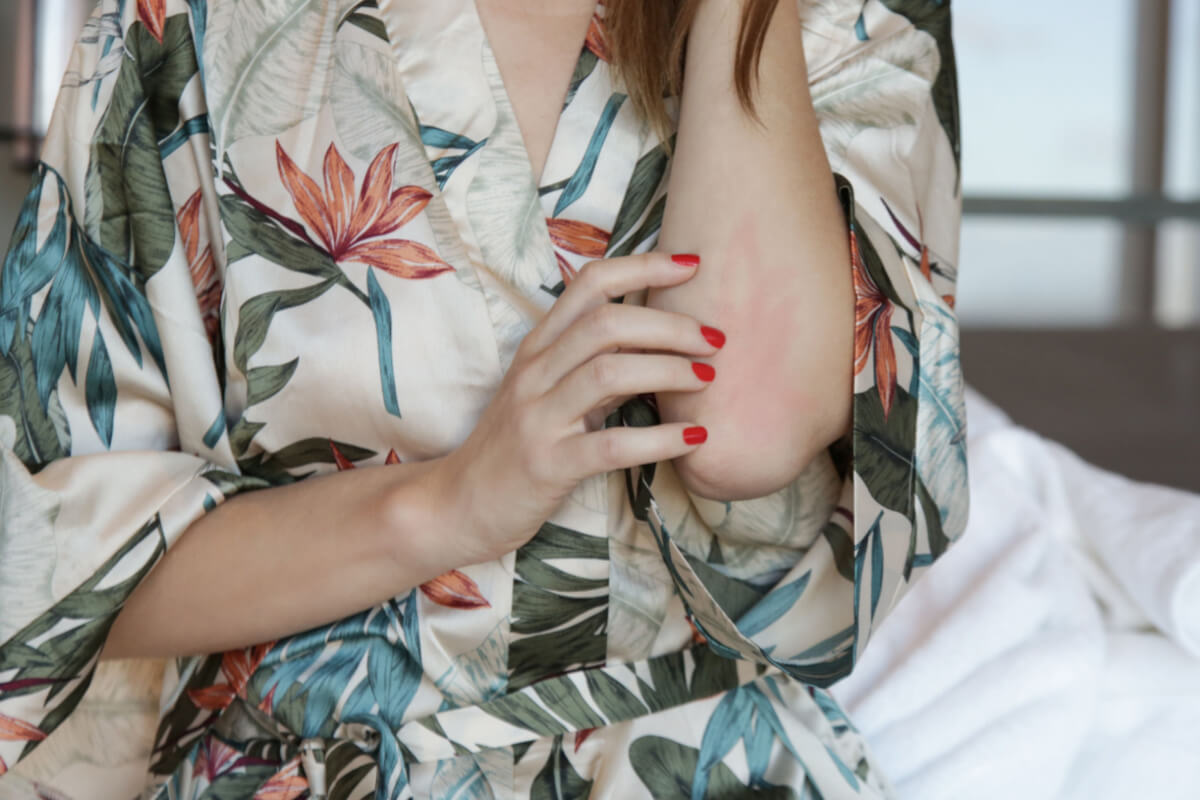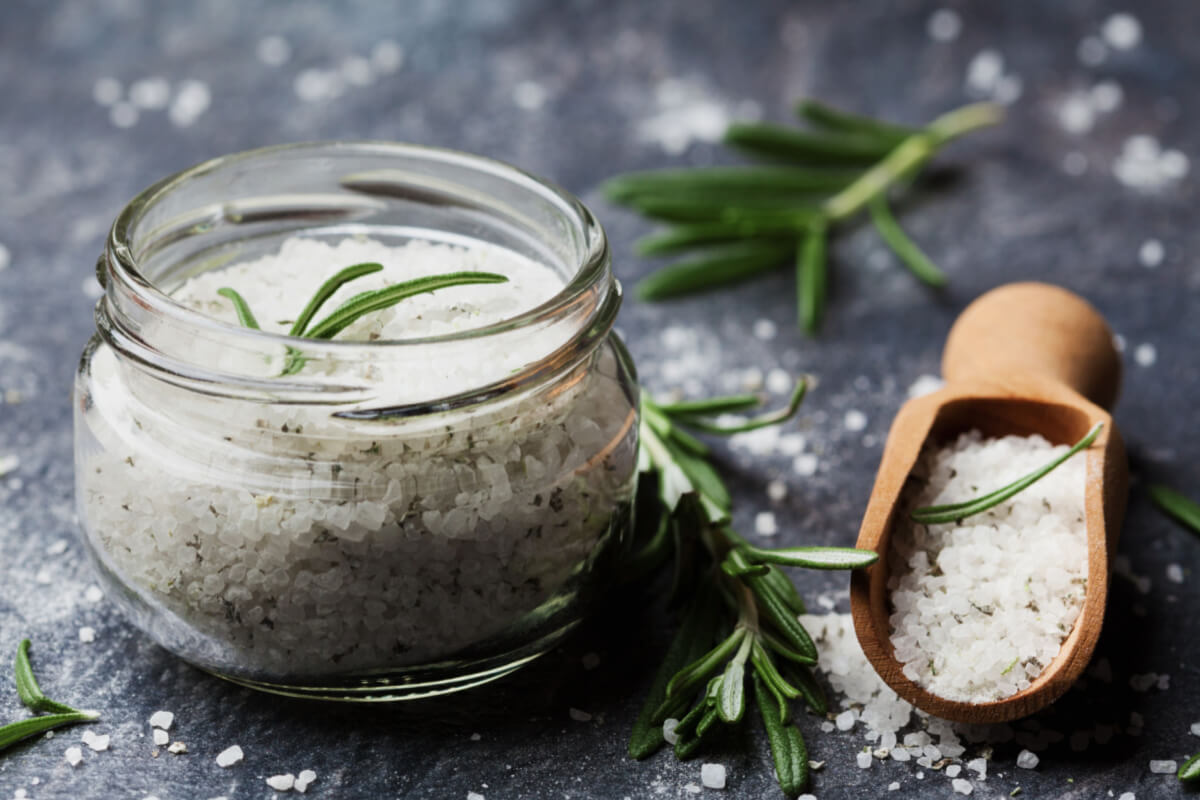Characterized by bright red, shiny, and smooth lesions in the folds of skin, inverse psoriasis affects anywhere from 3 to 36% of people with existing psoriasis. (8)(11) One of ten types of psoriasis, it can be itchy, painful, and embarrassing for those with the condition. (17) This, in turn, can significantly affect self-esteem, relationships, and quality of life. (11)

What is inverse psoriasis?
Like all types of psoriasis, inverse psoriasis is a chronic inflammatory autoimmune disease. Autoimmune diseases are any condition where the immune system attacks the body’s own healthy cells. (15) However, unlike the other forms of psoriasis, it doesn’t cause thick, raised, and scaly plaques on the skin. Instead, it creates red, smooth, and shiny plaques in the folds of the skin. It can typically be found in the armpits, genital area, groin, navel, and under the breasts. (17)(19)
A hard-to-treat condition, inverse psoriasis can cause painful fissures or cracks in the skin. Because it forms in skin folds, it can harbor moisture and can be prone to infection by yeast or bacteria. (11)(17)(22) These fissures and infections are more prevalent in people who are obese since the skin folds are deeper. (17)
There is no cure for psoriasis, including inverse psoriasis. But treatment may help to reduce outbreaks and symptoms. (18)
Did you know? Inverse psoriasis is also known as flexural psoriasis or intertriginous psoriasis. “Flexural” refers to skin surfaces that curve or fold while “intertriginous” refers to areas of the skin that rub together. (11)
Causes of inverse psoriasis
The cause of inverse psoriasis isn’t well understood. However, research suggests that those affected may have a genetic predisposition for developing the condition. (7)(18) Studies have also found that people with inverse psoriasis are also more likely to suffer from other diseases such as hypertension, obesity, or type 2 diabetes. (2)

Inverse psoriasis triggers
Certain factors can trigger an outbreak of inverse psoriasis. They include:
- Certain medicines
- Friction on deep skin folds
- Infections
- Injury to the skin
- Psychological stress
- Tobacco or alcohol use (9)
Did you know? Rubbing, scratching, and sweating can further irritate areas affected by inverse psoriasis. (9)
Diagnosing inverse psoriasis
Inverse psoriasis is diagnosed by a physical examination of the whole body, as well as allergy testing to rule out other conditions. However there is no specific test for inverse psoriasis. If there is any doubt, a skin biopsy may also be conducted. But because inverse psoriasis occurs in the folds of skin, it’s often referred to as “hidden” psoriasis and can be difficult to diagnose. (4)(20) Making matters worse, patients may be embarrassed to talk with their health care practitioner about their symptoms, especially when they affect the genital area. Studies show that they may also be uncomfortable discussing how the disease impacts their self-esteem, as well as their social and sexual life. (2)
Inverse psoriasis treatment
Inverse psoriasis requires a careful and targeted treatment plan. This is because areas of the skin that are affected are typically thin and sensitive. (16) Conventional common first-line treatments include topical immune suppressants and/or topical corticosteroids. (11)(16) Topical vitamin D analogs may also be used. However, according to a study that appeared in the journal Clinical Cosmetic and Investigational Dermatology, these topical drugs can cause side effects in the folds of the skin, making treatment a challenge. (11)
Tar-based products and emollients (substances that help soothe the skin) are standard second-line therapies for inverse psoriasis. Topical antimicrobials and antiseptics may also be prescribed to help treat skin infections. Oral medication may benefit individuals with severe cases resistant to topical treatments. However, evidence regarding the efficacy of oral medications in the treatment of this condition is low. (11)
Did you know? A strong smell emanating from the skin folds may indicate a secondary infection caused by the combination of moisture and bacteria or fungi. (19)
Inverse psoriasis diet
What you eat may impact your inverse psoriasis. While there isn’t a specific diet for the condition, dermatologists often suggest that those with any type of psoriasis eat a well-balanced, nutrient-dense diet. (23) A survey of 1,206 patients, which was conducted by researchers at the University of California, San Francisco, found that improvement was reported by respondents who ate less sugar, grains, and dairy. The most improvement was reported by those who also consumed less alcohol, gluten, and nightshade vegetables such as peppers or tomatoes. A large percentage—as much as 86%—of those completing the survey reported using dietary modification to help control their condition. (1)

How to treat inverse psoriasis at home
Adopting a healthy diet and losing weight if needed may improve your quality of life and may help to reduce the symptoms of inverse psoriasis. (10) Although there’s no specific exercise recommendation for inverse psoriasis, some research examining psoriasis as a whole reports that regular physical activity may improve overall health and the quality of life of sufferers. (5)
Since stress can exacerbate inverse psoriasis, mindfulness-based activities may help manage symptoms. (21) Proven ways to relieve stress include meditation and yoga. (3)(13)
Research has also found that some topically applied herbal extracts and nutrients may help to control the symptoms of inverse psoriasis. These include:
- Aloe vera
- Indigo naturalis extract
- Neem
- Oregon grape extract
- Sweet whey (21)
Taking a fish oil supplement may also help to reduce skin redness and inflammation. (12) However, check with your health care practitioner before using any natural or over-the-counter topical or oral treatments, especially if you are also using prescription medications for your inverse psoriasis.
Did you know? Studies have found that bathing in the Dead Sea—technically known as Dead Sea climatotherapy—improves the severity of psoriasis by as much as 76.7%. (6) However, you may be able to get similar results at home by bathing in magnesium-rich Dead Sea salts. (14)
The bottom line
Inverse psoriasis is a chronic, painful condition that causes bright red, smooth, and shiny lesions. It develops in the folds of the skin and can typically occur in “hidden” areas like the armpits, genitals, and under the breasts. There is no cure, but the condition can be managed with a healthy lifestyle as well as topical and oral treatments as needed. Although the condition can be embarrassing, it’s important to consult with your healthcare practitioner if you suspect you may have inverse psoriasis.
- Afifi, L., Danesh, M.J., Lee, K.M., Beroukhim, K., Farahnik, B., Ahn, R. S., Yan, D., … Liao, W. (2017). Dietary behaviors in psoriasis: Patient-reported outcomes from a U.S. national survey. Dermatology and Therapy, 7(2), 227–242.
- Aldredge, L.M. & Higham, R.C. (2018). Manifestations and management of difficult-to-treat psoriasis. Journal of the Dermatology Nurses’ Association, 10(4), 189-197.
- Bostock, S., Crosswell, A.D., Prather, A.A., & Steptoe, A. (2019). Mindfulness on-the-go: Effects of a mindfulness meditation app on work stress and well-being. Journal of Occupational Health Psychology, 24(1), 127–138.
- Cohen, J.M., Halim, K., Joyce, C.J., Patel, M., Qureshi, A.A., & Merola, J.F. (2016). Shedding light on the “hidden psoriasis”: A pilot study of the inverse psoriasis burden of disease (IPBOD) questionnaire. Journal of Drugs in Dermatology, 15(8):1011-1016.
- Custurone, P., Macca, L., Bertino, L., Di Mauro, D., Trimarchi, F., Vaccaro, M., & Borgia, F. (2021). Mutual influence of psoriasis and sport. Medicina (Kaunas, Lithuania), 57(2), 161.
- Emmanuel, T., Lybæk, D., Johansen, C., & Iversen, L. (2020). Effect of Dead Sea climatotherapy on psoriasis; A prospective cohort study. Frontiers in Medicine, 7, 83.
- Goblos, A., Varga, E., Farkas, K., Arvai, K., & Kemeny, L. (2021). Genetic investigation of inverse psoriasis. Life (Basel, Switzerland), 11(7), 654.
- Guglielmetti, A., Conlledo, R., Bedoya, J., Ianiszewski, F., & Correa, J. (2012). Inverse psoriasis involving genital skin folds: successful therapy with dapsone. Dermatology and Therapy, 2(1), 15.
- Inverse psoriasis. National Psoriasis Foundation. https://www.psoriasis.org/inverse-psoriasis/
- Kunz, M., Simon, J.C., & Saalbach, A. (2019). Psoriasis: Obesity and fatty acids. Frontiers in Immunology, 10, 1807.
- Micali, G., Verzì, A.E., Giuffrida, G., Panebianco, E., Musumeci, M.L., & Lacarrubba, F. (2019). Inverse psoriasis: From diagnosis to current treatment options. Clinical, Cosmetic and Investigational Dermatology, 12, 953–959.
- Millsop, J.W., Bhatia, B.K., Debbaneh, M., Koo, J., & Liao, W. (2014). Diet and psoriasis, part III: role of nutritional supplements. Journal of the American Academy of Dermatology, 71(3), 561–569.
- Park, C.L., Finkelstein-Fox, L., Groessl, E.J., Elwy, A.R., & Lee, S.Y. (2020). Exploring how different types of yoga change psychological resources and emotional well-being across a single session. Complementary Therapies in Medicine, 49, 102354.
- Proksch, E., Nissen, H.P., Bremgartner, M., & Urquhart, C. (2005). Bathing in a magnesium-rich Dead Sea salt solution improves skin barrier function, enhances skin hydration, and reduces inflammation in atopic dry skin. International Journal of Dermatology, 44(2),151-157.
- Psoriasis. (2020). Centers for Disease Control & Prevention. https://archive.cdc.gov/#/details?url=https://archive.cdc.gov/#/details?url=https://www.cdc.gov/psoriasis/index.htm
- Reynolds, K.A., Pithadia, D.J., Lee, E.B., & Wu, J.J. (2020). Treatments for inverse psoriasis: a systematic review. Journal of Dermatological Treatment, 31(8):786-793.
- Sarac, G., Koca, T.T., & Baglan, T. (2016). A brief summary of clinical types of psoriasis. Northern Clinics of Istanbul, 3(1), 79–82.
- Sbidian, E., Chaimani, A., Garcia-Doval, I., Do, G., Hua, C., Mazaud, C., Droitcourt, C., … Le Cleach, L. (2017). Systemic pharmacological treatments for chronic plaque psoriasis: a network meta-analysis. The Cochrane Database of Systematic Reviews, 12(12), CD011535.
- Stanway, A. (2022). Flexural psoriasis. Dermnet New Zealand. https://dermnetnz.org/topics/flexural-psoriasis
- Syed, Z.U. & Khachemoune, A. (2011). Inverse psoriasis: case presentation and review. American Journal of Clinical Dermatology, 12(2):143-6.
- Talbott, W. & Duffy, N. (2015). Complementary and alternative medicine for psoriasis: what the dermatologist needs to know. American Journal of Clinical Dermatology, 16(3):147-65.
- Weisenseel, P. & Reich, K. (2015). Psoriasis inversa . Hautarzt, 66(6):408-412. German.
- What should I eat if I have psoriasis. American Academy of Dermatology Association. https://www.aad.org/public/diseases/psoriasis/insider/diet/psoriasis-what-should-eat





